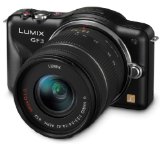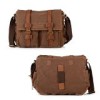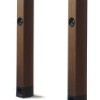Panasonic Lumix DMC-GF3KK 12 MP Micro 4/3 Mirrorless Digital Camera with 3-Inch Touchscreen LCD and 14-42mm Zoom Lens (Black) (Discontinued by Manufacturer)
Panasonic Lumix DMC-GF3KK 12 MP Micro 4/3 Mirrorless Digital Camera with 3-Inch Touchscreen LCD and 14-42mm Zoom Lens (Black) (Discontinued by Manufacturer)
- 12 Megapixel Ultra Compact System Camera
- Micro Four Thirds 14-42mm f3.5/5.6 Zoom Lens
- 3.0″ Free Angle Touch Enabled LCD
- Built-in Popup Flash
- Multiple Lens Options including 3D Still Lens,Memory Card Type: SD, SDHC and SDXC
Panasonic’s LUMIX DMC-GF3 realizes all the features you want from a bulky DSLR interchangeable lens camera, only it accomplishes this in an ultra compact point-and-shoot camera body about as wide and tall as a typical smart phone yet is lightweight and simple to master. This remarkable reduction in size and weight is thanks to advancements in new mirror-free camera technology, and large DSLR format sensors that are more compatible with a new class of compact Micro Four Thirds (MFT) System lenses
List Price: $ 549.99
Price:
Similar Posts






Happy so far. Compared to Olympus Pen Mini E-PM1,
I was deciding between the new Olympus Pen Mini E-PM1, Sony NEX C3, and GF3. Tried out the Olympus and GF3, and decided on the GF3. I got a better price on the GF3 than I could for the Pen Mini, but that was just icing on the cake, because the features on the GF3 meet my needs better.
Similarities between GF3 and E-PM1:
–body size about the same
–similar price range
–Micro Four-Thirds sensor
–both are the budget, easy-to-use version of their respective camera families
–instant-record movie button
–kit zoom lens 14-42mm
–neckstrap
–to my layman eyes the photo quality was about the same, as was auto-focus speed, though E-PM1 is billed as having the fastest auto-focus in this category.
The features that put the GF3 over the top for me:
–Price. I got a great deal on the GF3. Sony was just too expensive, though I’ve read great things about photo quality
–GF3 touchscreen, while not very responsive (resistive screen you have to press down on, rather than capacitive screen like iPhone), is very useful for quick adjustments. It just makes the camera easier to use, much like an iPad is easier to use than a laptop. Deleting batches of photos is much easier than using buttons. So is scrolling around a photo you’re reviewing in close-up. You can also touch to change the subject of focus, like on an iPhone.
–Flash is built in–not so on the Pen Mini or NEX. I’m not an “enthusiast” and have no intention of ever buying an external flash or viewfinder, so lack of a hotshoe was not an issue. Flash can also be tilted up to the ceiling (with some finger dexterity) to do a bounce-flash that brightens up indoor photos without that nasty flash look. Other 2 cameras come with a small add-on flash, but that’s just too much trouble.
–I like the physical on-off switch rather than the Pen Mini’s button
–Menus and options were slightly more intuitive, though I admit my previous camera was a Panasonic as well, so I may be used to their menus.
–In addition to dedicated movie button, there’s a dedicated “iA” full-auto button, which my wife can press to go to full-auto mode without digging into menus (it lights up).
–Big lens cap seems easier to handle.
–Comes with lens hood, which I might not use but is nice to be included.
–Battery charger is a one-piece mini brick with prongs built in, making it very portable. E-PM1 comes with a brick with power cord attachment.
I can’t speak to other reviewers’ issues with the pancake lens (since I don’t have it) nor the flash durability (since I’ve only had the camera a week).
About the Pen Mini:
–Body is about the same size as the GF3, but the kit zoom lens is smaller (shorter and narrower)
–Stabilization is in the body, not the lens like GF3. From what I read this is supposed to be an advantage, but I think it was adding noises to the videos I took (turning off stabilization stopped the noises). I haven’t noticed similar noises in GF3 videos with stabilization on.
–Lock on the lens to close it (but not open it) started to get annoying quickly.
–Flash was impressive–power is adjustable, and I think it auto-adjusts based on subject distance. From what I can see of the GF3, it fires full-power all the time, which can make photos look washed out. Fortunately the bounce-flash trick mentioned above avoids that problem.
–Neck strap attachment loops are hinged and tends to kind of make click-clack noises when handling the camera.
About me: my main photo subject is my 2 yr old daughter, so I was looking for a camera that would focus quickly, take decent pics in indoor light without flash, and still be small enough to throw in the diaper bag with room to spare for, well, diapers and stuff. These criteria rule out bulky SLRs, and most point-and-shoots. For my daughter’s first 2 years I had the Panasonic LX-3, a “high-end point-and-shoot”. The LX-3 produces great pics in good light, and decent pics in low light, but I find the focus is too slow (esp. in low light) now that my daughter is moving around (a LOT).
Long review and naturally biased toward the GF3, but I hope it helps your decision process!
Was this review helpful to you?

|Great option for point and shoot upgraders who are willing to invest into the system,
On the other hand, for those upgrading from a point and shoot camera like myself, this camera can be ideal. I came from a Canon S90, which I purchased a couple of years ago looking for a camera that does a better job in low light than the typical point and shoot. The S95 was definitely a step up from what I had before, but more recently I’ve become frustrated with the limitations of the sensor and was also interested in exploring the world of interchangeable lenses.
What I didn’t want, however, was to get a full DSLR. Portability is extremely important to me, any camera that can’t be slipped into a coat pocket or small bag is simply useless to me. No, the GF3 can’t fit into a pants pocket like my S95 did, but it’s still massively smaller than even the smallest DSLRs and it’s amongst the smallest models in the mirrorless camera class.
With small size taken care of, the next question is how good is the image quality? If you’re stepping up from a high-end point and shoot like I am you’re probably not going to notice a major difference in good lighting conditions, but where the GF3 blows my old S95 away is in low light situations. This performance does come with a caveat, however, which is that you need the right lens on the camera in order to get the low light performance you want. If you are not going to buy any additional lenses beyond the kit you’re not going to see any benefit over a high end point and shoot and you should probably consider one of those cameras (Canon S100, Olympus XZ-1, Fuji X100).
In my case I was happy to go out and purchase the 20mm f/1.7 Panasonic lens for low light photography. This lens allows me shoot at shutter speeds ranging from 1/40 to 1/100 of a second in very low light situations, at ISOs that would have ended up unacceptably grainy on my S90 (1600 or 3200). The result is that I’m getting indoor shots of pets and kids that I simply wasn’t able to get before.
Now, some people coming from a pro level camera will probably tell you that I’m crazy to shoot at ISO 3200 with this camera, but if you’re coming from a point and shoot you’ll find the noise so much better that it will be hard to notice. Yes there is a slight grain to shots, but it’s very fine and if all you’re doing is sharing photos on Facebook or via email it’s barely noticeable. I wouldn’t push it to 6400 ISO, however.
What about controls? In my case I find that the combination of the four-way controller, rotating dial and touch screen give me all the control points I want or need. I’ve got the FN button assigned to ISO control, and access Metering, Image Size and Flash controls via the touch screen Quick Menu, which can be customized to include a wide variety of controls. The four-way controller then gives me access to all the other controls I want: drive mode, white balance, focus point and exposure compensation. I shoot mostly in Program or Aperture Priority mode and am very happy with how quickly I can adjust my settings.
So, bottom line, if you’re upgrading from a point and shoot and are willing to take advantage of the fact that this is an interchangeable lens camera to buy the lens(es) that fit your needs, this can be a great upgrade camera for point and shooters. Don’t forget that the real long-term investment is in the lenses, you can always upgrade to a better body in the future and continue to use whichever great lenses you purchase on those future bodies, one of the great features of a camera system like this.
Was this review helpful to you?

|No regrets. This camera is sexy.,
I had no trouble importing clips to Corel Videostudio and editing them.
Was this review helpful to you?

|